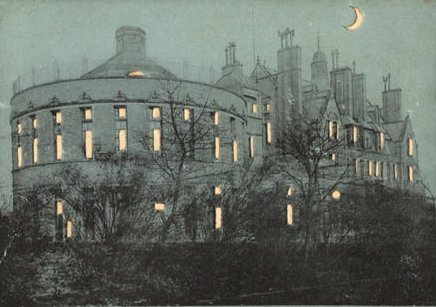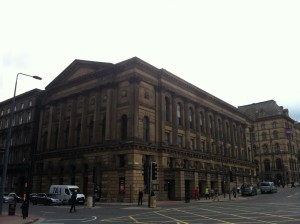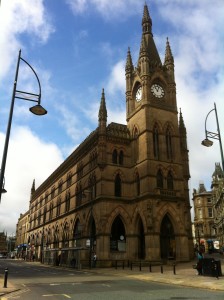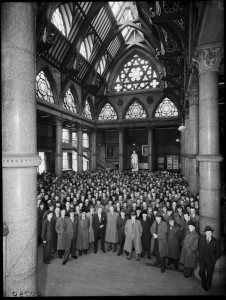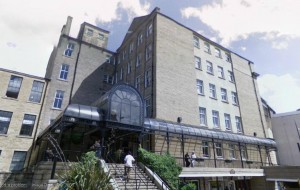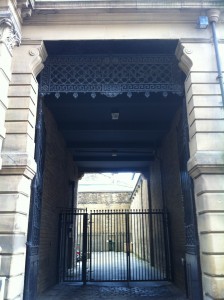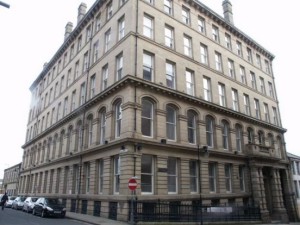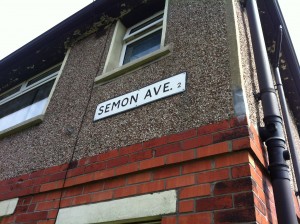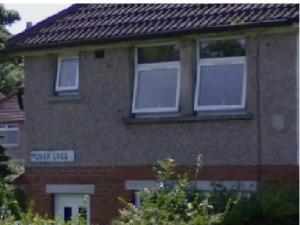Once the German Merchants had settled in the city, a need arose for impressive business premises, which would give them a competitive edge, standing out from the opposition. This expression of pride and vanity led to a building boom, which thrust up some monumentally fantastic architecture.
But these weren’t all just built for business; some were for civic purposes and others for the leisure and enjoyment of the towns people.
The building of the now demolished Eye and Ear hospital on Hallfield Road included a donation from Jacob Unna, who also helped fund the establishment of the Bradford Chamber of Commerce along with Sir Jacob Behrens, Charles Semon and Leopold Fulda.
Jacob Moser funded the Bradford Royal Infirmary and the Children’s Hospital near Oak Lane, Manningham. Additionally Moser gave £10,000, a vast sum of money in 1898 as a gift of benevolence towards the aged and infirm in his beloved Bradford. He also donated 12,000 books to Bradford Library.
St Georges Hall was built with funds, which came from the Jewish Community. Jacob Unna was among many other German Bradford Jews who promoted the building of the concert hall in 1853, which to this day retains it position as Bradford’s premier concert venue. It is even said that the great author and playwright J.B Priestley was astutely aware of the how strong musical tradition in Bradford owed much to Jewish support. Wealthy families such as the Halles, the Sichels and the Rothensteins were regular theatre attendees.
The Wool Exchange was funded by large donations from key investors whose business interest was the export of wool, and it is often asked whether the Stars of David in the top windows are deliberate nod to its Jewish financiers.
Cemeteries
There are a number of ornate funerary monuments to the merchants in the cemeteries at Undercliffe and at Scholemoor. At Undercliffe, the Behrens Family Monument stands as testimony to his wealth and sense of importance, in true keeping with the fashion of the high Victorian era. While in Scholemoor’s Reform cemetery the tomb of Charles Semon rises up to the branches of an adjacent tree, in a classical style, towering high above anyone who stands next to it.
Little Germany
There are still several surviving colossuses to Jewish commercial endeavour in Little Germany. This includes the magnificent head quarters now known as Merchants House built for Moser, Edelstein & Co. which is on Peckover Street. Behrens Warehouse, built for S.L. Behrens & Co. was around the corner, on East Parade. All that is visible to the visitor now is the wrought iron gate, which overlooks the street, with the company name moulded into the Romanesque design, painted in black with its roses and grids pattern. Other Jewish firms which took up residence in the area included Nathan Reichenheim at 4 Currer Street, along with the Reiss Brothers next door based at No. 6. The Heilbrons, Joseph Hirschel and Moritz Rothenstein also occupied business premises in this historic quarter. Moritz Rothenstein was the father of the two brothers, artists William Rothenstein and Alfred Rutherston who would both become heavily involved in the art world during the late 19th and early 20th centuries.
Charles Semon had his base only down the way a little at 25 Bolton Road. Semon also established a convalescent home in Ilkley, which he gave to the then equivalent of the town council, the Bradford Corporation. Generously he also granted a hefty bequest for its upkeep.
Of course no written piece on the buildings in this city with a strong Jewish connection without mention of the Synagogues. There are three Synagogue buildings in the wider Bradford area, only one of which is still used for its original purpose. The first to be built, and last to remain is the Bradford Synagogue on Bowland Street. This was opened in 1881, with Jacob Unna laying the foundation memorial stone the previous year. Built in the what is termed the Moorish Style, the house of prayer is built of an alternating design of yellow sandstone and red ashlar, with two entrances at each end, both displaying ornate stone work. The building is grade II* listed, and is considered to be one of the finest preserved synagogues in the country, as well being the second oldest surviving Reform synagogue in the UK. The interior is very finely decorated, and the Ark is a splendid example of ornate Byzantine inspired craftsmanship.
Nearby on Spring Gardens is the former Orthodox Synagogue of the Bradford Hebrew Congregation. Built in 1906, with subscriptions from the mostly Ashkenazi Orthodox Community, and a generous contribution from Jacob Moser, (then on a hiatus from being a town councillor), the Synagogue would survive for many years until its closure in 1970. Not as spectacular as its Reform counterpart, the building bears a humble green dome at its west end. Above the entrance can still be seen the Hebrew writing, of which the inscription reads ‘How goodly are your tents, O Israel’, quoting the verse from Ma Tovu, found in Numbers 24:5. The interior has been completely renovated for modern usage, and it now serves as primary school for the local music community, having been a Madrassa in the early part of this century and a car radio repair workshop and salesroom in the 1970′s and 1980′s. A black and white picture of the interior does however survive, and this shows the ark and and seating arrangements.
By 1969 it was clear that the old Synagogue, built all that time ago at the turn of the century had served its purpose in serving the local community. The community were no longer local, and therefore a new building had to be constructed. Built in the similarly named Springhurst Road, the very modern new shul (synagogue) would open in 1970, designed by the architect Basil Gillinson. Built of a light yellow coloured stone in a stacked pattern, rather than the more common over lapping brick design, the building is very angular in shape and appearance. Next to the entrance, there are three external alcoves with long vertical windows, and a forth smaller, lower alcove below the metal work, squarish Menorah emblem. The interior has an upper gallery where the women would sit, while the floor level synagogue has a central Bimah. The to either side of the ark there are curtains designed in the style of Tallits (Jewish prayer shawls), which hang down about 20 foot from the very high ceiling. These are made of a white linen, with black horizontal stripes towards the base.
Streets
As well there are three streets named after Charles Semon and Jacob Moser which are on the Swain House Estate in North Bradford, built between the wars, Moser Crescent and Avenue and Semon Avenue.There is also a Rehov Moser (Moser Street) in Tel Aviv, Israel which is named as ‘Ya’akov Mozer’. There are also a few street names which give reference to the German connection to Bradford. These include Blenheim Mount, Hanover Square in Manningham, as well as Hamm Strasse, which although not a direct Jewish connection was named after the German town of Hamm, after its became a Twin Town with Bradford in the mid 1970′s. In reciprocation, there is also a Bradford Road in Hamm.

